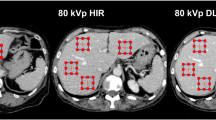Abstract
Purpose
To develop a protocol for abdominal imaging on a prototype 0.55 T scanner and to benchmark the image quality against conventional 1.5 T exam.
Methods
In this prospective IRB-approved HIPAA-compliant study, 10 healthy volunteers were recruited and imaged. A commercial MRI system was modified to operate at 0.55 T (LF) with two different gradient performance levels. Each subject underwent non-contrast abdominal examinations on the 0.55 T scanner utilizing higher gradients (LF-High), lower adjusted gradients (LF-Adjusted), and a conventional 1.5 T scanner. The following pulse sequences were optimized: fat-saturated T2-weighted imaging (T2WI), diffusion-weighted imaging (DWI), and Dixon T1-weighted imaging (T1WI). Three readers independently evaluated image quality in a blinded fashion on a 5-point Likert scale, with a score of 1 being non-diagnostic and 5 being excellent. An exact paired sample Wilcoxon signed-rank test was used to compare the image quality.
Results
Diagnostic image quality (overall image quality score ≥ 3) was achieved at LF in all subjects for T2WI, DWI, and T1WI with no more than one unit lower score than 1.5 T. The mean difference in overall image quality score was not significantly different between LF-High and LF-Adjusted for T2WI (95% CI − 0.44 to 0.44; p = 0.98), DWI (95% CI − 0.43 to 0.36; p = 0.92), and for T1 in- and out-of-phase imaging (95%C I − 0.36 to 0.27; p = 0.91) or T1 fat-sat (water only) images (95% CI − 0.24 to 0.18; p = 1.0).
Conclusion
Diagnostic abdominal MRI can be performed on a prototype 0.55 T scanner, either with conventional or with reduced gradient performance, within an acquisition time of 10 min or less.



Similar content being viewed by others
Data availability
Not Applicable.
References
An JY, Pena MA, Cunha GM, et al. Abbreviated MRI for Hepatocellular Carcinoma Screening and Surveillance. Radiographics. 2020;40(7):1916-1931.
Besa C, Lewis S, Pandharipande PV, et al. Hepatocellular carcinoma detection: diagnostic performance of a simulated abbreviated MRI protocol combining diffusion-weighted and T1-weighted imaging at the delayed phase post gadoxetic acid. Abdom Radiol (NY). 2017;42(1):179-190.
Feng L, Benkert T, Block KT, Sodickson DK, Otazo R, Chandarana H. Compressed sensing for body MRI. J Magn Reson Imaging. 2017;45(4):966-987.
Hammernik K, Klatzer T, Kobler E, et al. Learning a variational network for reconstruction of accelerated MRI data. Magn Reson Med. 2018;79(6):3055-3071.
van Beek EJR, Kuhl C, Anzai Y, et al. Value of MRI in medicine: More than just another test? J Magn Reson Imaging. 2019;49(7):e14-e25.
Runge VM, Heverhagen JT. Advocating the Development of Next-Generation, Advanced-Design Low-Field Magnetic Resonance Systems. Invest Radiol. 2020;55(12):747-753.
Bhat SS, Fernandes TT, Poojar P, et al. Low-Field MRI of Stroke: Challenges and Opportunities. J Magn Reson Imaging. 2020:e27324.
Sheth KN, Mazurek MH, Yuen MM, et al. Assessment of Brain Injury Using Portable, Low-Field Magnetic Resonance Imaging at the Bedside of Critically Ill Patients. JAMA Neurol. 2020.
Algarin JM, Diaz-Caballero E, Borreguero J, et al. Simultaneous imaging of hard and soft biological tissues in a low-field dental MRI scanner. Sci Rep. 2020;10(1):21470.
Campbell-Washburn AE, Ramasawmy R, Restivo MC, et al. Opportunities in Interventional and Diagnostic Imaging by Using High-Performance Low-Field-Strength MRI. Radiology. 2019;293(2):384-393.
Heiss R, Grodzki DM, Horger W, Uder M, Nagel AM, Bickelhaupt S. High-performance low field MRI enables visualization of persistent pulmonary damage after COVID-19. Magn Reson Imaging. 2021;76:49-51.
Bandettini WP, Shanbhag SM, Mancini C, et al. A comparison of cine CMR imaging at 0.55 T and 1.5 T. J Cardiovasc Magn Reson. 2020;22(1):37.
Pipe JG. Motion correction with PROPELLER MRI: application to head motion and free-breathing cardiac imaging. Magn Reson Med. 1999;42(5):963-969.
Pfeuffer J, van de Moortele PF, Yacoub E, et al. Zoomed functional imaging in the human brain at 7 Tesla with simultaneous high spatial and high temporal resolution. Neuroimage. 2002;17(1):272-286.
Eggers H, Brendel B, Duijndam A, Herigault G. Dual-echo Dixon imaging with flexible choice of echo times. Magn Reson Med. 2011;65(1):96-107.
Knoll F, Murrell T, Sriram A, et al. Advancing machine learning for MR image reconstruction with an open competition: Overview of the 2019 fastMRI challenge. Magn Reson Med. 2020;84(6):3054-3070.
Acknowledgements
We would like to acknowledge Dr. Jim Babb, PhD for assistance with statistical analysis.
Funding
This work was supported by the department of radiology.
Author information
Authors and Affiliations
Contributions
All authors have fulfilled ICJME criteria for authorship.
Corresponding author
Ethics declarations
Conflict of interest
Two of the authors are employees of Siemens Healthcare/Healthineers. Under an existing research agreement, these authors provided technical support with the modification of the MRI system and with sequence modifications for operation at 0.55 T. These authors did not have control over any other aspect of the study design or the study results.
Consent to Participate
Yes.
Consent for Publication
Not Applicable.
Ethical Approval
IRB approved prospective study.
Additional information
Publisher's Note
Springer Nature remains neutral with regard to jurisdictional claims in published maps and institutional affiliations.
Supplementary Information
Below is the link to the electronic supplementary material.
Rights and permissions
About this article
Cite this article
Chandarana, H., Bagga, B., Huang, C. et al. Diagnostic abdominal MR imaging on a prototype low-field 0.55 T scanner operating at two different gradient strengths. Abdom Radiol 46, 5772–5780 (2021). https://doi.org/10.1007/s00261-021-03234-1
Received:
Revised:
Accepted:
Published:
Issue Date:
DOI: https://doi.org/10.1007/s00261-021-03234-1




